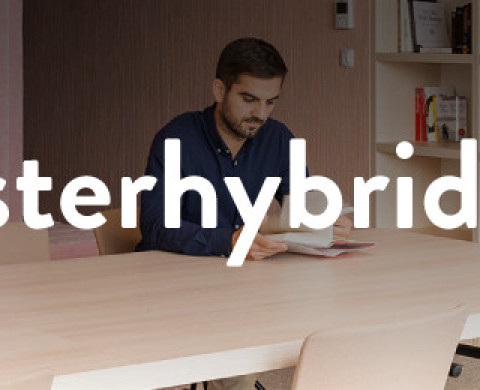How to build a happy community of hybrid employees
This week’s #masterhybridwork blog is all about community – the shared culture, sense of engagement and relationships we build in the workplace.
With the pandemic forcing huge numbers of employees to work from home, the bonds between colleagues – and between employees and their employer – have been weakened. Indeed, workplace communities all over the world are under unprecedented strain.
It’s a problem that isn’t going away. Research by the Harvard Business School shows that 81% of workers would prefer to work hybrid (mixing time in the office and remotely) post-pandemic, while 27% hope to work remotely full time indefinitely. It’s one of the reasons why we’ve developed our wide range of hybrid-friendly services and technologies. But for now, let’s look at the issues and solutions around hybrid workplace communities.

Low social cohesion reduces productivity
Your workplace community consists of interpersonal relationships that are crucial for effective collaboration (and producitivity), as well as your own personal wellbeing. Proximity is key. People working remotely are, naturally, physically more distant and their shared connections can weaken in time.
When these connections start to fall apart, group functions start to fail too. People don’t participate in group events, they stop conforming to group norms, communication drops off. As a result, collaboration wanes, it takes longer to make decisions and solve problems, and conflicts are tougher to resolve.
Besides this, research has shown that poor workplace relationships can have impact on our health – impacting cardiovascular and immune functions, for instance – and slow the recovery from injury and disease.
The big three problems in the hybrid community
Some of the structures that create and fuel these workplace relationships can be replaced in the hybrid space. It’s a mix of the practical and the technological. The better your systems and processes, the better your options for ‘substituting proximity’ – from better videoconference platforms and project management tools. Equally, promoting rules for meetings and providing clear performance management helps keep everyone on track.
Let’s look in detail about three of biggest issues remote working has raised, and what you can do to make sure your bottom line doesn’t suffer.
Trust is hard to build and maintain
We all need to be trusted at work. Companies benefit from trust among their employees. People at high-trust firms have 106% more energy and 13% fewer sick days. They are 50% more productive, 76% more engaged, 40% less likely to burn out and 29% more satisfied with their lives, research says. According to HBR, “companies previously allowed select employees to work from home, either because those specific employees were highly trusted or because their work allowed managers to measure their output and hold them accountable.”
However, as HBR continues, “remote working may be tied to lower trust… we interpret a lack of physical contact as a signal of untrustworthiness”. Essentially, some people simply struggle to trust their colleagues. And even if they do, it’s still difficult to demonstrate that trust when they don’t see or hear from those colleagues.
We’re now in a new normal of ethics and social norms
Business behaviours that have been in place for generations have disappeared between the digital and physical space. Now, we’re navigating a new set of ethical and social norms driven by the arrival of round-the-clock digital-age communications.

These digital rules (or digital social norms) often haven’t been defined. When you meet someone, we’re used to shaking hands. But what about over Teams or Zoom? What is a formal greeting? How do you start a meeting with colleagues you email dozens of times a day? These insecurities build on the loss of connection to the people we work with.
It’s harder to read colleagues
We’ve also lost instant feedback. When we communicate in person, we intuitively read other people’s body language and expressions. But digitally, we’re often lucky to even see a person’s face – and simply can’t adjust our behavior to match the flow of a conversation. Put together with all these issues, it’s easy to see how a lack of community can impact performance and wellbeing.
What can you do about these challenges?
Based on our expertise, we’ve put together a list of activities and grouped them into 4 main areas that can help you overcome the hybrid working headaches:
Support physical interactions within and among teams
- Make sure that teams have regular meetings and leaders have regular in-person one on ones.
- Acknowledge that team rituals, such as coffee time or birthday celebrations, are important.
- Organise cross team events like sports days, and encourage teams to mingle, for example sitting with different colleagues at company weekend lunches.
Help leaders create tight-knit teams
- Encourage them to network with other leaders/departments.
- Make sure they keep their teams informed about what’s going on across the company.
- Give them opportunities to increase their colleagues profiles and celebrate their successes.
- Create a task force to solve big organisational issues or develop product innovations.
- Introduce mentoring and coaching programmes.

Give newcomers and more junior employees more support
- Make sure they get more face time with colleagues so they can learn and develop network.
- Include social elements to onboarding, e.g. ‘social buddies’ that spend time with them in person.
Develop a hybrid working etiquette
- Include rules about how to behave in the new set-up, like whether it’s OK to have the camera off during a meeting.
- Develop workshops or training modules on useful topics, such as how to prepare and facilitate hybrid projects.
- Set boundaries so people know where they stand, for example whether you have to be available at all times.
Don’t miss out on any of our blogs. Sign up for our newsletter and we’ll keep in touch:
"*" indicates required fields




